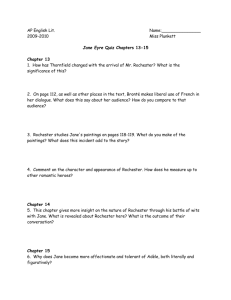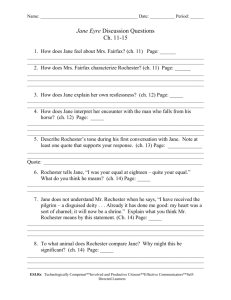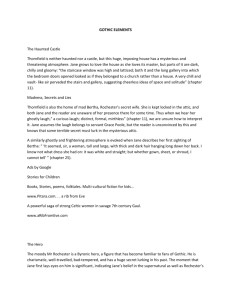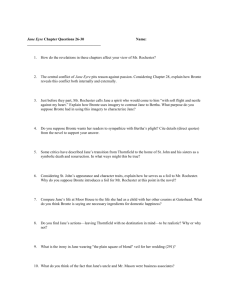Old English and Medieval 6 week Project
advertisement
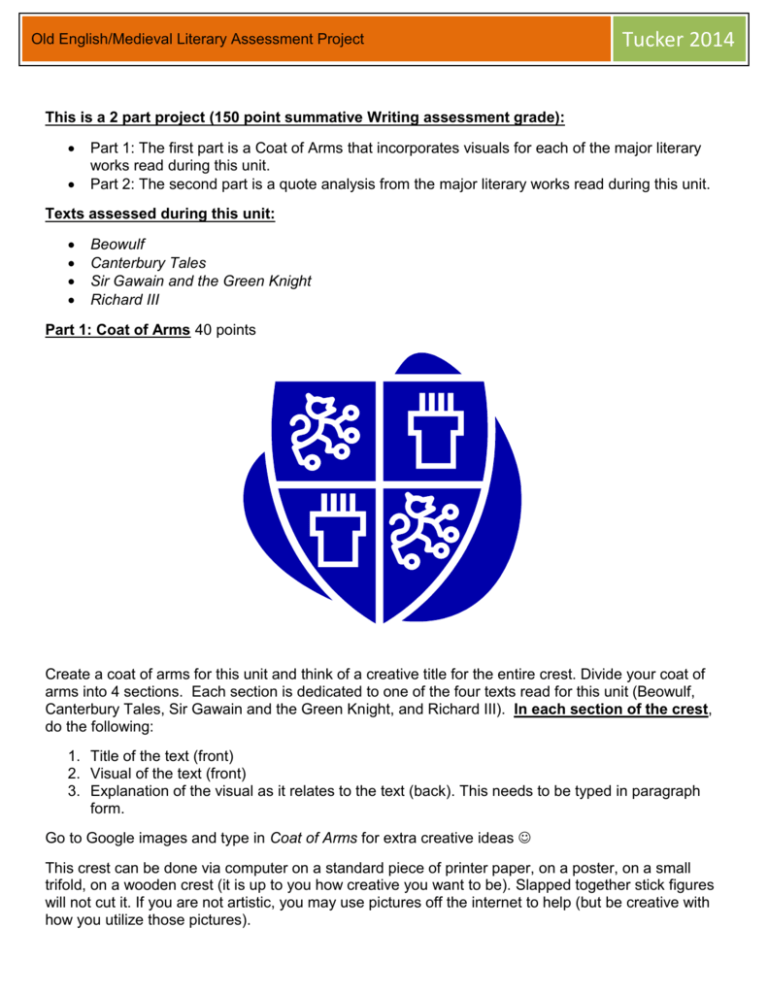
Old English/Medieval Literary Assessment Project Tucker 2014 This is a 2 part project (150 point summative Writing assessment grade): Part 1: The first part is a Coat of Arms that incorporates visuals for each of the major literary works read during this unit. Part 2: The second part is a quote analysis from the major literary works read during this unit. Texts assessed during this unit: Beowulf Canterbury Tales Sir Gawain and the Green Knight Richard III Part 1: Coat of Arms 40 points Create a coat of arms for this unit and think of a creative title for the entire crest. Divide your coat of arms into 4 sections. Each section is dedicated to one of the four texts read for this unit (Beowulf, Canterbury Tales, Sir Gawain and the Green Knight, and Richard III). In each section of the crest, do the following: 1. Title of the text (front) 2. Visual of the text (front) 3. Explanation of the visual as it relates to the text (back). This needs to be typed in paragraph form. Go to Google images and type in Coat of Arms for extra creative ideas This crest can be done via computer on a standard piece of printer paper, on a poster, on a small trifold, on a wooden crest (it is up to you how creative you want to be). Slapped together stick figures will not cut it. If you are not artistic, you may use pictures off the internet to help (but be creative with how you utilize those pictures). Old English/Medieval Literary Assessment Project Tucker 2014 Part 2: Quote Assessment for each text (Beowulf, Canterbury Tales, Sir Gawain and the Green Knight, and Richard III). 100 points For each text, choose 3 quotes from the text. Copy the quote and include the page numbers from the book and the line numbers as well. 1. Quote 1: Highlights history/politics/themes of the time period 2. Quote 2: Incorporates Examples of Imagery/Figurative Language (similes, metaphors, alliteration, etc.) 3. Quote 3: Focuses on story (major plot points, setting, characters, etc.) There are 4 texts, so there should be 3 for each text (12 Quotes total). With each quote, do the following in paragraph form (7-10 sentences): 1. Explain the quote as it appears in the context of the story 2. Explain how the quote highlights 1,2, 3 from above list Additional Requirements Typed (5 points) MLA Formatted: Heading, Times New Roman, 12 point font, double spaced (5 points) Bonus Point Opportunities: Visual Organization and Presentation of Quotes (+10 total) Creative Cover and Binding +5 Title pages and Dividers +5 Example from Jane Eyre: Quote 1: Highlights history/politics/themes of the time period “I was thinking, sir, that very few masters would trouble themselves to inquire whether or not their paid subordinates were piqued and hurt by their orders,” [said Jane]. “Most things free-born will submit to anything for salary; therefore, keep to yourself, and don’t venture on generalities of which you are intensely ignorant. However, I mentally shake hands with you for your answer…the manner was frank and sincere…Not three in three thousand raw school-girl governesses would have answered me as you have just done,” [responds Rochester] (Bronte, 161). Analysis: This is the first real conversation between Jane and Mr. Rochester. Here, Jane speaks candidly to Mr. Rochester, surprising him because of her youth and because of her station. In this conversation, their stations in society are highlighted: Jane is the “paid subordinate” and Mr. Rochester is “master.” In the Victorian era, the class system was very much alive and adhered to. Mr. Rochester is a member of the upper, wealthy class and Jane is a governess. While governesses were not the lowest peasant class, they certainly were considered working class and thus not on an equal social level as the wealthy upper class. This passage is interesting because while they acknowledge their social standing, they are essentially defying those labels by conversing so openly and equally. Bronte was definitely making a statement about the class system of the Victorian Era. Old English/Medieval Literary Assessment Project Tucker 2014 Quote 2: Imagery/Figurative Language “I am no better than the old, lightning-struck chestnut-tree in Thornfield orchard,” he remarked, ere long. “And what right would that ruin have to bid a budding woodbine cover its decay with freshness?” “You are no ruin, sir-no lightning struck tree; l you are green and vigorous. Plants will grow about your roots, whether you ask them or not, because they take delight in your bountiful shadow; and as they grow they will lean toward you, and wind around you, because your strength offers them so safe a prop.” (Bronte, 515) Analysis: This passage occurs at the end of Jane Eyre when Jane returns to Thornfield and finds it burned to the ground. She is told that Mr. Rochester was injured in the fire caused by his insane wife, Bertha Mason. He lost one of his arms and is blind from debris that fell on him when he tried to save Bertha. After the accident, Mr. Rochester retired to a secluded country house, Ferndean. It is there that Jane finds him and it is there that they have the above conversation. This passage perfectly incorporates both imagery as well as a conceit, also known as an extended metaphor. Here, Jane and Rochester each compare his broken state to that of the chestnut-tree that was split in half by lightning. Rochester sees himself as broken and unworthy of Jane’s love. Jane, however, tells him that he is still strong and worthy of her love. The passage uses words like green and vigorous to paint a visual image in the reader’s head of a thriving tree that other plants seek shelter from, just as Jane seeks shelter from Rochester. Quote 3: Focuses on story (plot, setting, characters, etc.) “That is my wife,” said [Rochester]. “Such is the sole conjugal embrace I am ever to know. Such are the endearments which are to solace my leisure hours! And this is what I wished to have (laying his hand on my shoulder); this young girl, who stands so grave and quiet at the mouth of hell, looking collectedly at the gambols of a demon. I wanted her just as a change after that fierce ragout…look at the difference! Compare these clear eyes with red balls yonder-this face with that mask-this form with that bulk; then judge me…and remember with what judgment ye judge ye shall be judged! Off with you now. I must shut up my prize” (Bronte, 343). Analysis: This passage occurs on the day of Jane and Rochester’s wedding. It takes place in the mysterious third floor of Thornfield Hall. During their wedding ceremony, Jane and Rochester’s are interrupted by Mr. Mason and his lawyer. They reveal that Mr. Rochester has a living wife and that the marriage cannot take place. Rochester then takes Jane to the third floor of his house to reveal to her, and the others present, his wife, Bertha Mason. This is the climax of the plot of the story. Here, Jane’s stoicism is emphasized against the insanity of Bertha Mason. Rochester asserts that he was willing to betray Jane’s trust and the laws of man in order to have her. This also emphasizes how Jane and Rochester are foils for one another. She is the virtuous, pure figure in the novel that remains morally upright even in the face of ultimate temptation (Rochester); Rochester, on the other hand, represents the corrupt, immoral figure in the novel. Old English/Medieval Literary Assessment Project Tucker 2014 Rubric (Point Break Down): Part 1: Coat of Arms: Beowulf Visual Explanation (4 Points) (6 Points) Canterbury Tales Visual Explanation (4 Points) (6 Points) Sir Gawain and the Green Knight Visual (4 Points) Explanation (6 Points) Richard III Visual Explanation (4 Points) (6 Points) Part 1Total ________________/40 points Part 2: Quote Analysis Beowulf (25 points) Inclusion of 3 quotes with page numbers and line numbers (10 points) Analysis of Quotes (15 points) Canterbury Tales (25 points) Inclusion of 3 quotes with page numbers and line numbers (10 points) Analysis of Quotes (15 points) Sir Gawain and the Green Knight (25 Points) Inclusion of 3 quotes with page numbers and line numbers (10 points) Analysis of Quotes (15 points) Richard III (25 Points) Inclusion of 3 quotes with page numbers and line numbers (10 points) Analysis of Quotes (15 points) Typed (5 points) MLA Formatted (5 Points) Part 2 Total Points ________________________/110 Total Part 1 _______+Total Part 2 ______=_____+ Bonus Points______/150 = ______% (grade) Old English/Medieval Literary Assessment Project Tucker 2014
